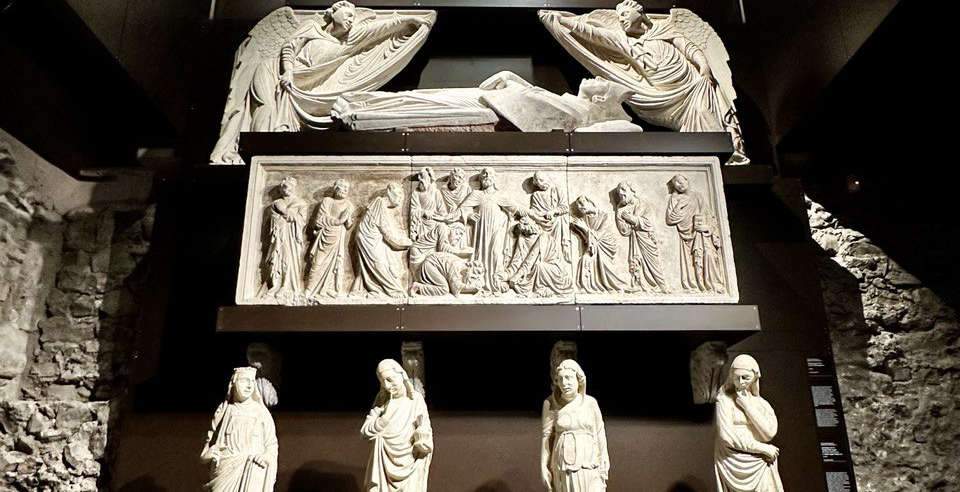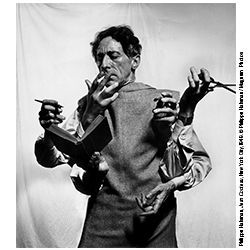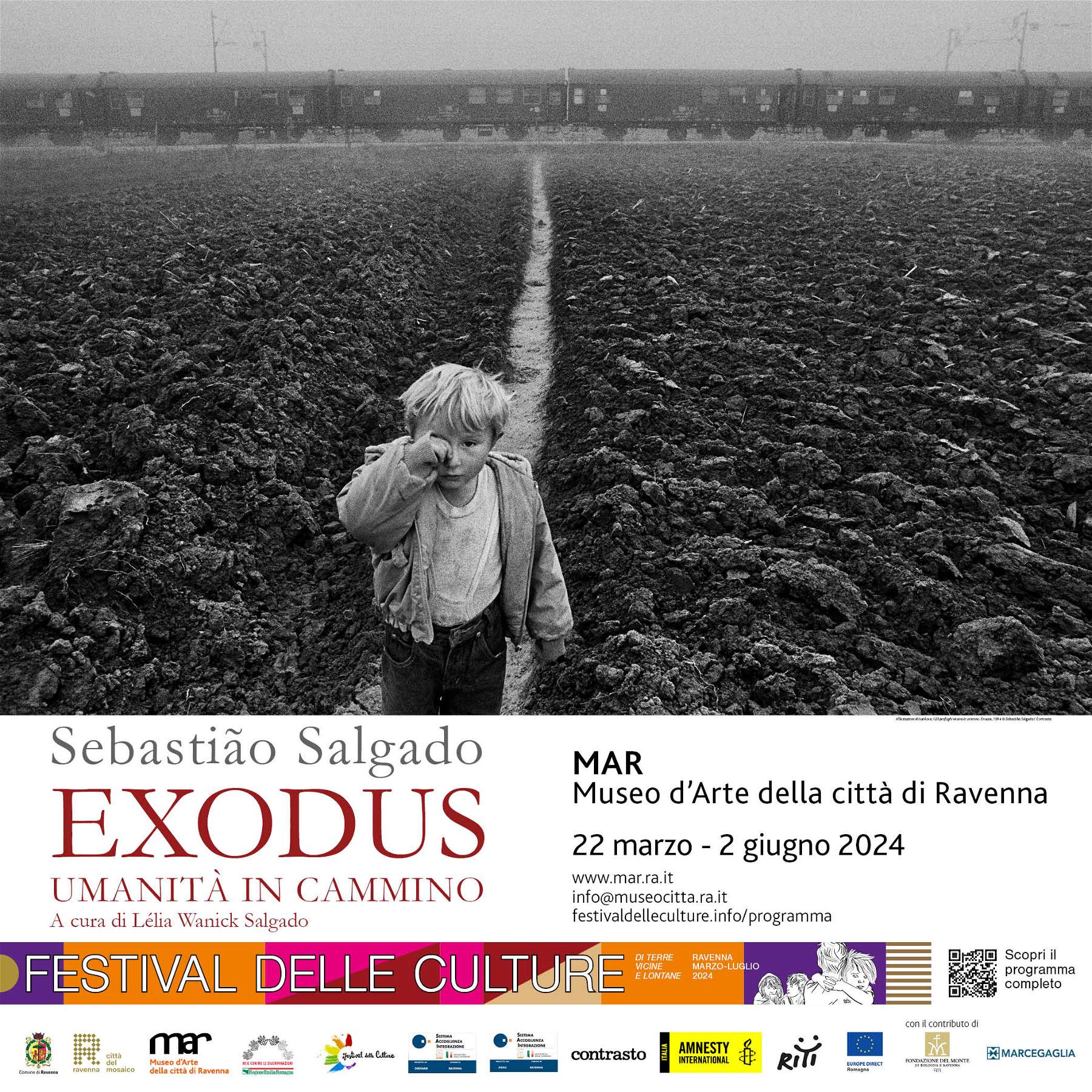Genoa, recomposed the Fieschi Monument, a masterpiece of Gothic sculpture
Important recovery for Genoa’s historical and artistic heritage. As of today, April 5, the Diocesan Museum in fact welcomes visitors with a significant novelty: the Fieschi Monument, a masterpiece of Gothic sculpture that was previously divided into 124 fragments, has been reassembled and is on display on a wall more than eight meters high, restoring the imposing grandeur of the work. This achievement is the culmination of a long and demanding work that began on November 11, 2020, when the project was presented to the city, and concluded today with the inauguration of the new display of the Fieschi Monument. This transformation can be considered a kind of rebirth of a masterpiece, as the extraordinary complexity of the project emerged from the very beginning, during the rediscovery of the 124 fragments and during the 40 months of work that followed. This lengthy process involved various stages, from the dismantling of the original monument, the restoration work, the assembly of the architectural fragments, to the creation of the exhibition space and the complex placement of the individual elements.
At each stage of this complex project, highly collaborative and synergistic teamwork was essential. Clario Di Fabio and Francesca Girelli of the University of Genoa contributed their scientific expertise, while Giovanni Tortelli of Studio GTRF Tortelli Frassoni acted as designer and director of the exhibition work, supported by his collaborators Alessandro Polo and Rocco Pagnoni. The team of restorers, led by Iacco Morlotti, worked with care, as did the technicians and operators of Sciutto srl. All these professionals, united and coordinated by the museum management, worked together to successfully complete this ambitious project.
The success of this project was also made possible thanks to the contribution of several institutions. The Soprintendenza Archeologia, Belle Arti e Paesaggio for the metropolitan city of Genoa and the province of La Spezia played a key role, offering their support and contributing to the financing of the conservation work through the Ministry of Culture. The City of Genoa, through the Cultural Policies Department and the Museum of St. Augustine, actively collaborated as the owner and custodian of part of the fragments of the Fieschi Monument. The parish of Santa Maria Maddalena and San Girolamo Emiliani generously loaned parts of the funerary complex owned by them, while the Cathedral of San Lorenzo participated in the project. The University of Genoa made a contribution through its scientific investigations and involvement of the Fieschi Monument in the MEMID (Memory and Identity) project. Finally, the support of the Compagnia di San Paolo Foundation has been decisive: already a promoter of the museum refurbishment and redevelopment in the basement of the Museum, the Foundation has been the main supporter of this new exhibition project. The collaboration of other sponsors was equally crucial to the success of the project. The Italian Bishops’ Conference, through the OttoxMille, made a significant contribution, along with the Fondazione Conservatorio Fieschi, Coop Liguria, AON S.p.A, the Perlenghini family, the Genoa Chamber of Commerce and the Piaggio Foundation. Also decisive was the support of the San Lorenzo Impresa Sociale Foundation, which is responsible for managing the Diocesan Museum and the Treasure Museum.
At the end of this long and complex process, the result obtained fully confirmed the initial ambitions of the project. Although it was not possible to achieve a complete reconstruction of the monument, given the absence of complete historical and figurative data and the missing or as-yet unidentified parts, a step forward from past attempts has been taken: the goal, they let the Diocesan Museum know, was to pay homage to the grandeur and ambitious grandeur of what represented, together with Giovanni Pisano’s tomb of Margaret of Brabant, the most significant sculptural complex of the Genoese 14th century. Despite its shortcomings, this monument remains one of the best preserved of those that decorated the city’s churches in the 14th century. The monument, which stood about ten meters in height, underwent a significant restoration in 2019, during which the 124 original fragments were brought together and the monument was rearranged. In addition, more ancient statues from the original marble set were displayed. Today, visitors have the opportunity to admire the monument in every detail: thanks to an access created at the ground floor level, it is possible to enjoy a privileged view of the upper part of the monument, which highlights its original grandeur and grandeur.



The opening of the Monument to the public on April 5, 2024, as part of IANUA (the year dedicated by the city of Genoa to the Middle Ages) is just the beginning of a series of cultural promotion initiatives related to the funeral complex and the history of the Fieschi family. These initiatives will include a study day next fall and the publication of a volume in the spring of 2025, which will illustrate the results of the project and further explore the history and importance of the Fieschi Monument.
“Today,” says Traditions Councilor Paola Bordilli, “we are here to celebrate the rebirth of a masterpiece. The restoration and new display of the monument dedicated to Cardinal Luca Fieschi is a source of great pride for the entire city. In fact, today Genoa reclaims one of its treasures, a symbol of its history that is once again accessible in all its grandeur and majesty, thanks in part to the work of the Diocesan Museum, which houses it. Few funerary monuments can boast such a prestigious location: the Fieschi monument has such grandeur that it can be called one of the most important monumental tombs of the medieval period. All of this has been made possible by the studies, restorations and refurbishment work, tangible proof of the professionalism behind a recovery such as this. My thanks go to all those who have made this possible and, in particular, to the Archdiocese of Genoa with whom we are building a synergistic and highly collaborative relationship with the ultimate goal of our beautiful city. The placement of the work in such an important place will have a great impact that I am sure will be truly exciting: so I invite Genovese and Tourists to rediscover this city heritage.”

 Detail of the Fieschi
Detail of the Fieschi Detail of the
Detail of the

 Photograph from
Photograph from

 Recomposition
Recomposition Recomposition
Recomposition Recomposition
RecompositionHistory of the monument
The mausoleum of Cardinal Luca Fieschi, erected between the fourth and fifth decades of the 14th century, constituted the first private funerary monument within the Cathedral of San Lorenzo in Genoa. This privilege was granted by virtue of the prestige of the Fieschi family, clearly signaling their status and assertion of power, a trend that the lineage confirmed several times until the 16th century. The Fieschi Tomb was an imposing monumental structure of great historical and artistic significance. Created to house the Cardinal’s remains, the monument represented one of the earliest and most significant examples of Italian Gothic, in which architecture and plastic decoration complemented each other perfectly. The complex ensemble, centered on the figure of the deceased, lying down and surrounded by “Pleurants,” constituted a work of extraordinary beauty and suggestion.
Luca Fieschi (Genoa, c. 1270 - Avignon, 1336), a member of the Genoese family of the Counts Fieschi di Lavagna, was ordained cardinal by Boniface VIII with the title of S. Maria in Via Lata at the age of less than 30. He became one of the leading figures in the Genoa of his time, not only for his devotion and dedication, but also for the role of benefactor, politician, and diplomat he exercised in Europe during his 36 years as cardinal. Luca Fieschi was known for his love of history, books and the fine codices he collected, as well as works of art. Among the best-known episodes involving Luca Fieschi were his intervention in defense of the Pontiff during the affair of the “Slap of Anagni,” his assignment to accompany Henry VII to Rome to be crowned emperor in 1312, as ordered by Pope Clement V, and his decisive role in the Guelphs’ seizure of power in Genoa in 1313. Particularly significant was his mission to England in 1317, aimed at achieving peace between King Edward II and King Robert Bruce of Scotland, which, however, was not perfected until several years later.
Luca Fieschi lived mainly in Avignon between 1318 and 1336, but in 1326 he became Archpriest of the Basilica of Santa Maria Maggiore in Rome. His influence and his family’s wealth were evident, as evidenced by the fact that in 1327 he loaned the City of Genoa a considerable sum, obtaining as pledge the Sacred Catinus, one of the most valuable relics in the Treasury of the Cathedral of San Lorenzo. Despite his many responsibilities and assignments, Luca Fieschi’s bond with Genoa remained strong until his death. He wished to be buried in the Cathedral of San Lorenzo in his hometown, where he had served as Canon.
The history of the Fieschi Tomb is rich in vicissitudes, and the amount of work required for its realization was truly impressive, as was the exceptional nature of its monumental plastic rendering. Initially, Luca Fieschi’s remains were kept in Avignon: his body was embalmed and displayed in the church of the Friars Minor, before finally being laid to rest in the church of the Virgin Mary. However, when the remains were transferred to Genoa, the funerary monument and chapel were not yet complete. The first documented work stoppage was between 1341 and 1342. The executors were dissatisfied with the direction of the work and had already twice replaced their Genoese representatives: in 1341, Emanuele Fieschi and the clerics Antonio da Biella, Matteo da Monza, and Lamberto da San Miniato; in 1342, Tedisio Abate di San Siro di Genova, Maestro Venturino da Bergamo, Canon of the Cathedral, and Filippo Oltremarino.
Between 1336 and 1341, two masters from Pisa were called in to make the sculptures. Later, work resumed with another workshop in charge of completing the missing parts, including the statue of the Madonna and Child. The magnitude and importance of the work can be guessed from the allocation of funds for the purchase and transport of the marble, five times greater than that intended for the Tomb of Margaret of Brabant, consort of Emperor Henry VII of Luxembourg, and 2.85 times greater than that intended for the emperor himself.
Over the centuries, the Fieschi Tomb has undergone various remodeling, following the vicissitudes of the lineage. Scholars of 14th-century art have formulated several hypotheses about its original location in Genoa Cathedral and the changes that occurred over time. Among them, Professor Clario Di Fabio, known for his contributions to the study of medieval Genoa, has played a prominent role. Di Fabio is the coordinator of the Master’s Degree Course in Art History and Enhancement of the Artistic Heritage at the University of Genoa and
“The Fieschi Tomb,” Di Fabio explains, “was located in the presbyterial area, behind the High Altar and facing the ancient Altar of the Baptist, but to better understand its significance, a premise must be made. From the thirteenth century onward, that area symbolized the public space par excellence not only because the Cathedral belonged to the Municipality, but precisely because of the presence of the Altar of the Baptist, the city’s patron saint, thus with all its intrinsic devotional drive, but also with the precipitous civic interest that came with it. The race ’to be near the Baptist,’ to be clearer, was significant, and the only ones who succeeded in winning it were the Fieschi family, holders of great influence in the city at the time in all respects, and also in the sphere of the Cathedral, since they controlled the Chapter and were in charge of its management. In the first half of the thirteenth century Pope Innocent IV, of the Fieschi lineage, donated precisely on the space of the Altar of the Baptist 36 silver lamps to illuminate it lavishly. Later, when he was elected Pope, albeit for only 40 days, his nephew Ottobono, that is, Hadrian V (who had already had the altar of St. Hadrian made in that space), left in his testamentary will the wish to be buried in Genoa in front of the Altar of the Baptist. The City of Genoa, which was supposed to give him permission, never responded. Well, what Pope Adrian V did not obtain succeeded to his nephew Luca Fieschi by reaffirming in that part of the presbytery the totalizing imprinting of the family. It was the culmination of a hegemonic and familial, politico-ideological and personal design, which involved both the Cathedral and its venerated relics - from the Sacred Basin to the Ashes of the Baptist - and the very presence of its powerful lineage in the city.”
In the early decades of the 16th century, the Fieschi family went through a period of low fortune due to multiple political events, culminating in its ouster from the city after the failed coup orchestrated by Gianluigi Fieschi. In addition, in 1529, an explosion in a gunpowder factory located in the cellars of the Archbishop’s Palace caused severe damage to the Cathedral’s presbytery. This event prompted the decision to change the location of many previously erected monuments, including those belonging mainly to the Fieschi family and dating from the 14th and 15th centuries, as well as the sepulchral monument of Doge Leonardo Montaldo.
The Tomb of Luca Fieschi underwent a series of displacements over the centuries. Initially, it was placed in the wall of the inner façade of the right transept of the Cathedral. Later, during the seventeenth century, it was reduced and selectively reassembled above the new Porta del Soccorso. The various parts of the monument were then dispersed in various places in the Cathedral, in the courtyards and even above the vaults of the minor aisles, until they were rediscovered and enhanced only in the late nineteenth century.
During this period, numerous restoration works were undertaken in St. Lawrence. The parts of the monument that had been mounted on the Porta del Soccorso were dismantled and relocated to the De Marini Chapel, where they remained for some time simply leaning against the wall.
In the 1920s, there was talk of recomposing the original harmony of the Fieschi Monument, thanks to the contribution of Orlando Grosso and the project of the Museum of Ligurian Sculpture and Architecture. The Museum of St. Augustine assumed a key role in the preservation of the monument. However, the Diocesan Museum, under the direction of Giulio Sommariva, current curator of the Museum of the Ligurian Academy of Fine Arts, also engaged in the latest attempts to enhance the Fieschi Tomb.
“This is a real work in progress,” Clario Di Fabio continues. “The most important aspect is to have, in part, tidied up the situation. At present we have identified the components that can really be reconstituted because they have their own established, precise place in the tomb context, with reference to their counterparts from the first half of the 14th century between Italy and France. Among the most significant achievements is having reassembled one of the most relevant parts, with a curvilinear course, bearing an Annunciation in the center and figures of saints on either side. In general there will be important and obvious novelties, as a reasonably certain arrangement will be given for the main sculptural parts, while the others will be placed in such a way as to evoke an earlier situation in an impactful, exciting arrangement.”
 |
| Genoa, recomposed the Fieschi Monument, a masterpiece of Gothic sculpture |
Warning: the translation into English of the original Italian article was created using automatic tools. We undertake to review all articles, but we do not guarantee the total absence of inaccuracies in the translation due to the program. You can find the original by clicking on the ITA button. If you find any mistake,please contact us.




















